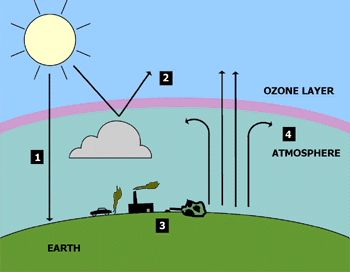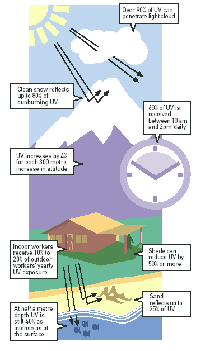|
|
 |
|
|
|
 |
| |
|
|
 |
Weather
More |
More about environmental changes and the human health.
|
|
|
|
|
 |
|
The phrase "environmental health" in industrialized countries conventionally refers to the adverse effects on human health of exposure to specific physical and chemical agents in the local environment. The emphasis has thus been on contaminants in air, water, soil and food. Epidemiologists and toxicologists continue to focus on the quantification of these effects — either by studying human populations or experimental animals.
The spectrum of "global environmental" hazards to health includes:
|
- global climate change due to the accumulation of greenhouse gases in the lower atmosphere;
|
 |
 |
 |
|
Fig. 1.: 1. Most of the sun's energy reaches the Earth. (The ozone layer shields the Earth from the sun's harmful ultraviolet radiation.)
2. About 30 percent of the energy is reflected back into space.
3. Burning of fossil fuels and deforestation increase carbon dioxide in the atmosphere. Added to this are chlorofluorocarbons (human-made gases used in spray cans, refrigerants and insulations) and methane (from landfills, farming and swamps).
4. Together, these gases form a "blanket" which traps energy, thus warming the Earth.
source:http://www.texasep.org
|
|
 |
 |
|
2. UV radiation levels are influenced by: sun elevation, latitude, cloud cover, altitude, ozone, ground reflection
source:www.who.int
|
|
 |
- stratospheric ozone depletion.
Possible effects of solar ultraviolet radiation on human health:
on skin (malignant melanoma, non-melanocytic cancer, sunburn, chronic sun damage, photodermatoses),
on the eye (lens opacity, acute solar retinopathy, cancer of the cornea and conjunctiva, etc.),
on immunity and infection (suppression of cell mediated immunity, increased susceptibility to infection, impairmentof prophylactic immunization, activation of latent virus infection),
other direct effects (cutaneous vitamin D production: prevention of rickets, possible benefit for hypertension, etc.; altered general well-being: sleep/wake cycles, mood, etc.),
indirect effects (on climate, food supply, infectious disease vectors, air pollution, etc.)
|
this is occurring at a rapid rate, and entails both the disappearance of useful species and genes and the weakening of various ecosystems thereby reducing the flow of nature’s life-supporting "goods and services";
|
 |
 |
 |
|
3. Even the remaining North American forests are still being cleared for new developement.
source: library.thinkquest.org
|
|
|
|
 |
- desertification, depletion of fertile soil, groundwater and natural fisheries; this is undermining the productivity of food-producing ecosystems, thereby offsetting expected gains from genetically modified organisms, precision farming and aquaculture;
4. Left: Goat seeks food in the sparsely vegetated Sahel of Africa
Right: Off-road vehicles significantly increase soil loss in the delicate desert environment
source: pubs.usgs.gov
|
- various chemical pollutants, familiar as part of industrialization’s legacy of local pollution, are now being recognized as persistent and globally pervasive. Some appear to affect neurological, immune and reproductive systems, and can no longer be considered to have specific and limited toxicity.
|
 |
 |
 |
|
5. Humans are emitting more greenhouse gases into the atmosphere Cars, trucks, home and business heating, and power factories are responsible for about 98% of US carbon dioxide emissions and 18% of nitrous oxide missions.
source: www.wrh.noaa.gov
|
|
|
In addition to the large-scale environmental changes, global trends within human societies have also had significant effects on human health.
The prime determinant of population health in the medium-to-long term is the life-supporting capacity of the environment.
There needs to be a clearer understanding of the fundamental ecological relationship between environmental conditions, climatic conditions and human health.
|
|
Measurement of population health
We need a measure to describe the health of population, which is a quite complex parameter. The disease burden comprises the total amount of disease or premature death within the population. To compare burden-fractions attributable to several different risk factors requires, first, knowledge of the severity/disability and duration of the health deficit, and, second, the use of standard units of health deficit. The widely-used Disability-Adjusted Life Year (DALY) is the sum of
- years of life lost due to premature death (YLL)
- years of life lived with disability (YLD).
YLL takes into account the age at death, and YLD takes into account disease duration, age at onset, and a disability weight reflecting the severity of disease. Based on this measure, the estimated impacts of climate change in 2000 were the follows in the different regions. |
| Region |
Total Dalys(1000s) |
DALYs/million population |
| Africa region |
1894 |
3071,5 |
| Eastern Mediterranean region |
768 |
1586,5 |
| Latin America and Caribbean region |
92 |
188,5 |
| South-East Asian region |
2572 |
1703,5 |
| Western Pacific region (w/out developed countries) |
169 |
111,4 |
| Developed countries (and Cuba) |
8 |
8,9 |
| WORLD |
5517 |
920,3 |
Examples of how diverse environmental changes affect the occurrence of various infectious diseases in humans. |
| Environmental changes |
Examples diseases |
Pathway of effect |
| Dams, canals, irrigation |
Schistosomiasis |
D Snail host habitat, human contact |
|
Malaria |
D Breeding sites for mosquitoes |
|
Helminthiasies |
D Larval contact due to moist soil |
|
River blindness |
Ñ Blackfly breeding, Ñ disease |
| Agricultural intensification |
Malaria |
Crop insecticides and D vector resistance |
|
Venezuelan haemorraghic fever |
D rodent abundance, contact |
| Urbanization, urban crowding |
Cholera |
Ñ sanitation, hygiene; D water contamination |
|
Dengue |
Water-collecting trash, D Aedes aegypti mosquito breeding sites |
|
Cutaneous leishmaniasis |
D proximity, sandfly vectors |
| Deforestation and new habitation |
Malaria |
D breeding sites and vectors, immigration of susceptible people |
|
Oropouche |
D contact, breeding of vectors |
|
Visceral leishmaniasis |
D contact with sandfly vectors |
| Reforestation |
Lyme cliease |
D tick hosts, outdoor exposure |
| Ocean warming |
red tide |
D toxic algal blooms |
| Elevated precipitation |
Rift valley fever |
D Pools for mosquito breeding |
|
Hantavirus pulmonary syndrome |
D Rodent food, habitat, abundance |
D increase Ñ reduction
|
About this page:
author: Sándor Szalai - Hungarian Meteorological Service
scientific reviewing: Dr. Ildikó Dobi Wantuch / Dr. Elena Kalmár - Hungarian Meteorological Service, Budapest
last updated: 2004 - 02 - 24
|
 http://www.who.int/globalchange/climate/en/ccSCREEN.pdf http://www.who.int/globalchange/climate/en/ccSCREEN.pdf
 http://whqlibdoc.who.int/hq/2000/WHO_SDE_OEH_00.4.pdf http://whqlibdoc.who.int/hq/2000/WHO_SDE_OEH_00.4.pdf
 http://www.texasep.org http://www.texasep.org
 library.thinkquest.org library.thinkquest.org
 pubs.usgs.gov pubs.usgs.gov
 http://www.wrh.noaa.gov http://www.wrh.noaa.gov
 www.who.int www.who.int
|
|
 |
|









